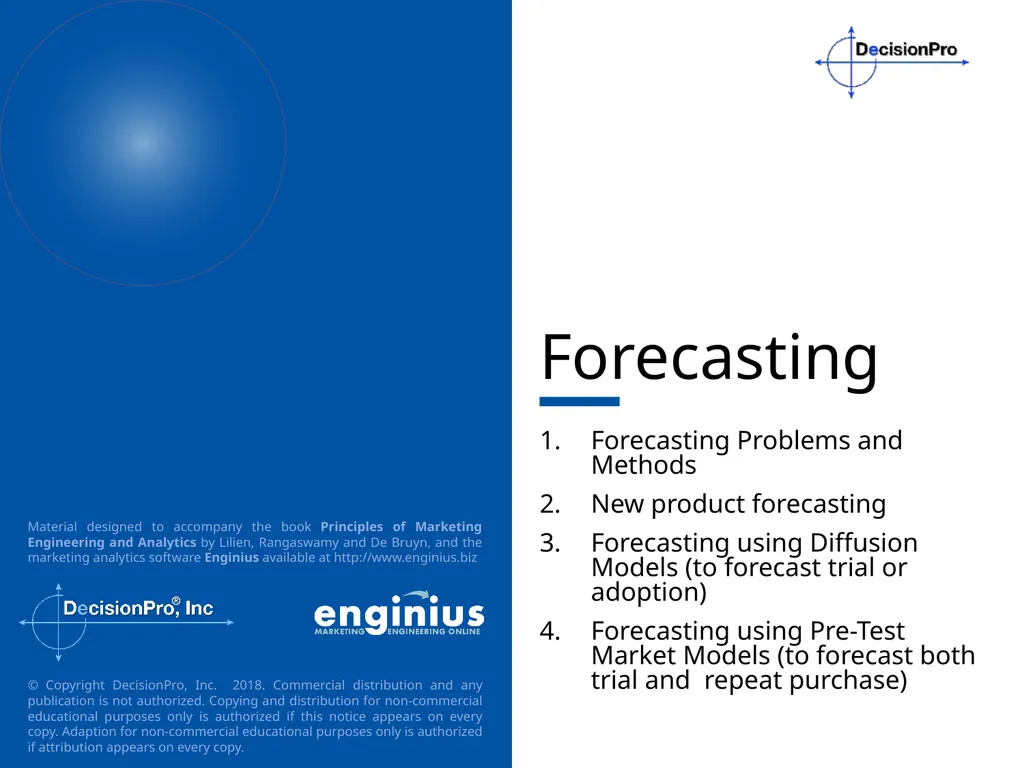Forecasting Forecasting Problems and Methods New
Author : mitsue-stanley | Published Date : 2025-06-27
Description: Forecasting Forecasting Problems and Methods New product forecasting Forecasting using Diffusion Models to forecast trial or adoption Forecasting using PreTest Market Models to forecast both trial and repeat purchase Managerial Issues
Presentation Embed Code
Download Presentation
Download
Presentation The PPT/PDF document
"Forecasting Forecasting Problems and Methods New" is the property of its rightful owner.
Permission is granted to download and print the materials on this website for personal, non-commercial use only,
and to display it on your personal computer provided you do not modify the materials and that you retain all
copyright notices contained in the materials. By downloading content from our website, you accept the terms of
this agreement.
Transcript:Forecasting Forecasting Problems and Methods New:
Forecasting Forecasting Problems and Methods New product forecasting Forecasting using Diffusion Models (to forecast trial or adoption) Forecasting using Pre-Test Market Models (to forecast both trial and repeat purchase) Managerial Issues Related to Forecasting What is the purpose of developing the forecast? What, specifically, do we want to forecast (e.g., market demand, technology trends)? How important is the past in predicting the future? What influence do we have in constructing the future? What method(s) should we use to develop the forecast? What factors could change the forecast? Forecasting Methods Methods for Forecasting New Product Sales Early stages of development Chain ratio method Judgmental methods Scenario analysis Diffusion model Later stages of development Pre-test market methods Test-market methods Chain Ratio Method (Estimate of Online Grocery Sales) Number of households (2000 census) 105 million Grocery purchases per household per year (52x120) $5300 % of sales from Supermarkets and grocery stores 84% (Progressive Grocer) Households with children (married and unmarried – Census) 35% % of households with Internet access (Census Bureau) 58% Will order groceries online if available (Survey) 25% Discount of survey intentions 50% Online grocery shopping availability (guess) 40% Awareness given availability (guess) 50% Market forecast: $ ??? Intent-to-Buy Scale Used for Generating Some Inputs to Chain Ratio Definitely would buy Probably would buy May or may not buy (May be excluded from the scale) Probably would not buy Definitely would not buy Who Are They? New Product Forecasting Models That We Consider Forecasting the pattern of new product adoptions (Bass Model) Forecasting market share for new products in established categories (Assessor pre-test market model) Forecasting using conjoint analysis Forecasting Based on “Newness” of Products New to World New to Company Repositioning Pre-test market model Line Extensions Simple pre-test market models (e.g., Bases) Breakthroughs—Major Product Modifications Bass model/Conjoint “Me Too” Products Conjoint/Pre-test market models Lo Hi Lo Hi Overview of “Stage-Gate” New Product Development Process Design Identifying customer needs Sales forecasting Product positioning Engineering Marketing mix assessment Segmentation Opportunity Identification Market definition Idea generation Testing Advertising & product testing Pretest & prelaunch forecasting Test marketing Introduction Launch planning Tracking the launch Life-Cycle Management Market response analysis & fine tuning the marketing mix; Competitor monitoring & defense Innovation at maturity Go No Go No Go No Go No Reposition Harvest The Bass Diffusion Model of New Product Adoption The model attempts to answer the question: When will customers adopt a new product














